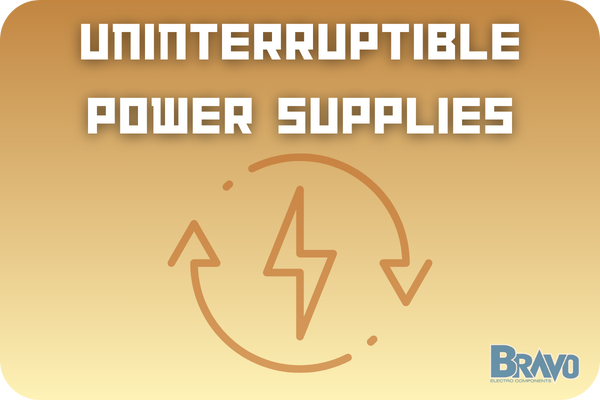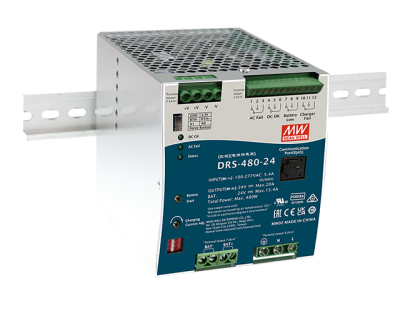
Operational continuity is non-negotiable in many industries, from manufacturing to medical. The risk of downtime is a constant source of stress. Power supplies fail and outages occur unpredictably - typically striking at the worst times.
The good news is that they don’t have to impact your day-to-day. An uninterruptible power supply (UPS) can keep things running smoothly no matter what life throws at you. These are an investment in productivity and peace of mind.
How does an uninterruptible power supply work, though? These systems bridge the gap between power failures and system reliability. They instantly supply backup energy while regulating voltage to prevent damage to connected equipment.
Learn more about how a UPS can elevate your operation below, or take the next step towards setting yours up with the help of Bravo Electro - where you’ll discover the premier provider of AC DC power supply and DC DC converters online from trusted brands like MEAN WELL!
What is an Uninterruptible Power Supply (UPS)?
A UPS is designed to provide backup power and voltage regulation anytime power interruptions or fluctuations strike. They safeguard against voltage anomalies such as surges, sags, or complete outages.
These are common in a variety of industrial environments that rely on consistent, ongoing operations - be it for medical equipment or manufacturing robots. Industries like telecommunications and automation rely on them as well.
They’re commonly compared to backup generators, but the key difference is that a UPS can provide instantaneous power without even the slightest interruption. We also have a comparison of redundant power supply vs UPS in our blog if you want to explore differences there.
There are a few important components that make a UPS work - and understanding these will help you better grasp how the uninterruptible power supply works in a moment:
- Rectifier: Converts incoming AC power to DC power, which then charges the battery backup or supplies energy to the inverter for consistent and stable energy flow, even when the incoming power supply is erratic.
- Inverter: Converts stored DC power from the battery back into AC power so it’s usable for connected equipment. It keeps the output voltage steady and ensures it matches the requirements of the devices in operation.
- Battery Backup: Stores energy to provide immediate power during outages or fluctuations. Its capacity determines how long the UPS can sustain connected systems during a power failure.
- Bypass Switch: Lets power flow directly from the main supply to connected equipment, bypassing the internal components of the UPS. Useful for maintenance or in situations where the UPS system experiences a fault but power delivery must continue.
It’s worth noting that there are a few different types of uninterruptible power supplies, which we’ll cover in greater detail later on. Just know for now that there are offline/standby UPS, line-interactive UPS, and online/double-conversion UPS.
We’ll help you choose among these styles and account for other factors, like power supply wattage, power supply voltage, power supply efficiency ratings, power supply standards in just a few moments. First, how does a UPS work?
How Does an Uninterruptible Power Supply Work?
The best part of investing in a UPS for your operation is that it works automatically to maintain consistent power delivery to your most critical devices and equipment. But maybe you want to know what’s going on behind the scenes: how does an uninterruptible power supply work?
Power Flow in Normal Operation
In normal operating conditions the UPS pulls power from the main electrical supply and delivers it to connected equipment. The power is first passed through a rectifier to convert AC to DC, which powers the inverter and charges the battery simultaneously.
The inverter then converts DC back to AC for output for stable and regulated voltage that matches the requirements of the load. We have a more detailed guide on how to convert DC to AC power supply if you’re interested.
This double-conversion process (in online UPS systems) prevents even minor fluctuations or surges in the utility power from affecting the connected devices.
Switching During Power Interruptions
As much as you try to avoid it, power interruptions are always a risk. When they happen, the UPS instantly switches to its battery backup. This happens instantaneously, you wouldn’t even notice a change since it takes just milliseconds.
The next steps will vary depending on the type of UPS in question:
- Offline UPS systems engage the inverter only during interruptions, causing a short delay.
- Line-interactive UPS systems use an autotransformer to adjust voltage before activating the battery.
- Online UPS systems maintain continuous power flow by already operating through the rectifier and inverter, eliminating any transfer time.
Battery Charging and Management
A UPS continuously monitors and charges its battery to maintain full capacity. This is where the rectifier comes into play, supplying a consistent current to the battery. Some more sophisticated UPS systems take things a step further with more advanced battery management features:
- Temperature compensation: Adjusting charge rates based on battery temperature to extend lifespan.
- Battery health monitoring: Regular scans for potential issues like reduced capacity or aging cells.
- Automatic self-testing: Keeps the battery ready to perform during an outage at all times.
Voltage Conditioning and Surge Protection
Beyond providing backup power a UPS also conditions incoming voltage to protect equipment from surges, sags, and spikes. It smooths out irregularities so only stable power reaches sensitive devices.
This is especially important in industrial environments where fluctuations are common due to heavy machinery. The UPS serves as a surge protector, shielding connected equipment from sudden voltage spikes that could damage circuits or reduce the lifespan of components.
Load Considerations for UPS Systems
We’ll talk more about this in a moment, but selecting the optimal UPS involves careful consideration of the total power requirement of all connected equipment.
You’ll need to account for both the rated power capacity (the maximum load the UPS can support continuously) and peak power handling (short bursts of high power demand without tripping or reducing performance).
Some loads, such as motors or industrial control systems, require UPS models with specialized features like higher inrush current handling. Don’t worry, this is something our experts here at Bravo Electro can help you navigate.
Benefits of Using a UPS in Your Operation
So, what does an uninterruptible power supply do that makes it such a great investment in your operation? We’ve touched on a few of the benefits already but we want to make it clear that this is worth exploring if you don’t have a UPS in place already.
Preventing Equipment Damage
Power fluctuations, surges, and outages can cause irreparable damage to sensitive equipment such as industrial controllers, medical devices, and telecommunications systems.
These all have their own costs, and it’s reason enough to invest in a UPS to prolong their lifespan alone. A UPS shields these systems from voltage irregularities by delivering stable, conditioned power. Like we just mentioned above, they’re basically a “surge protector.”
Ensuring Operational Continuity
More importantly, though, a UPS keeps your critical operations online around the clock. You never have to worry about downtime with one of these in place.
Whether supporting industrial automation systems, emergency lighting, or transportation networks, the instantaneous backup power from a UPS prevents disruptions.
Enhancing Safety
Sometimes keeping devices, equipment, and systems running isn’t about productivity. It can quite literally be the difference between life and death, as is the case with emergency lighting, fire alarms, security cameras, and medical devices.
The stakes are too high to take any chances with downtime on these devices. A UPS not only keeps them working consistently in any conditions but also supports safe shutdown procedures for machinery.
This can prevent hazardous situations caused by abrupt power loss in high-risk environments such as manufacturing plants or chemical processing facilities.
Reducing Maintenance Costs
Frequent power fluctuations and outages accelerate wear and tear on equipment. This goes back to protecting connected devices. Providing stable power and minimizing electrical stress can extend the lifespan of connected devices, reducing the need for repairs and replacements.
Energy Efficiency in Modern UPS Systems
Modern UPS designs are designed with energy efficiency at the forefront with features such as eco-mode operation, adaptive load management, and intelligent battery charging.
Each of these plays a role in reducing energy consumption and operational costs. Not only will your electricity bills be lower, but your system’s environmental footprint will be as well!
Sourcing the Right Uninterruptable Power Supply For Your Needs
You know how a UPS works and why it’s worth integrating into your operation. The only question now is, what power supply do I need?
Remember, personalized guidance is just a click or call away at Bravo Electro. In the meantime, here are some tips on picking the perfect UPS for your unique needs.
Assessing Power Requirements
The first step is to figure out how much power your operation draws to determine what the UPS needs to be capable of handling.
Assess load capacity in kilowatts (kW) or kilovolt-amperes (kVA), and be sure to account for potential future expansions. Provide a buffer in your sizing requirements for unexpected surges.
Choosing the Right UPS Type
There are a few different uninterruptible power supply types, and choosing the right one is key to maximizing their value in your operation. Here’s an overview of each:
- Offline/Standby UPS: Provides basic protection by activating the inverter and battery backup only during power outages or extreme fluctuations. Commonly used in non-critical applications.
- Line-Interactive UPS: Enhances voltage regulation by actively stabilizing power input with an autotransformer. Ideal for environments with frequent but minor fluctuations.
- Online/Double-Conversion UPS: Provides continuous power by constantly running the load through both the rectifier and inverter. This ensures zero transfer time and optimal protection, making it suitable for mission-critical industrial applications.
Key Features to Look For
There’s a lot that goes into picking the perfect UPS, and it’s easy to get overwhelmed by various power supply topologies and power supply certifications. Just focus on the most important features:
- Scalability: The UPS may need to be expanded or adapted to meet future needs.
- Battery Management: Look for intelligent charging and monitoring systems to extend battery life and ensure readiness.
- Surge Protection: Confirm the unit can shield against voltage spikes.
- Monitoring and Connectivity: Advanced models offer real-time performance monitoring and remote management to simplify maintenance.
- Efficiency Modes: Eco-mode options can reduce operational costs without compromising reliability.
As far as safety standards and certifications are concerned, it will be somewhat industry and application-specific. The medical standards vary from that of industrial automation.
That being said, the basics like UL and CE certifications are a good starting point. You may need a system that’s IEC-certified in accordance with international requirements, too. Take environmental hazards into account as well, like dust and moisture, and choose between the various NEMA vs IP ratings.
Sourcing Considerations
The only thing left to figure out at this point is which of the many power supply manufacturers and suppliers can provide what you’re looking for. This is not something you should take lightly as it will impact just how reliable and effective your system is.
It also determines whether or not you’ll have access to custom power supplies, which can be a dealbreaker in some scenarios where standard solutions don’t fit your requirements.
The good news? Your search for the #1 selection of power supplies and related equipment ends here at Bravo Electro.
Why Trust Bravo Electro as Your UPS Supplier?
Bravo Electro is a premier supplier of industrial-grade power solutions from world-renowned manufacturers like MEAN WELL. We pair the industry’s best products with unparalleled customer support for a seamless sourcing experience from A to Z.
You can find everything from a modular power supply to DIN rail power supply, external power supply, enclosed power supply, battery charger, and much, much more. You can also narrow your search based on voltage:
Not sure one of our off-the-shelf solutions will meet your needs? We have a custom power supply program to tailor one of these to your exact requirements. It’s quick, intuitive, and cost-effective. It all starts with a conversation with one of our electrical engineers.
So, browse our catalog or reach out directly to take the next step towards a UPS you can count on to deliver around-the-clock protection for your most critical operations today!
Final Words on How a UPS Works
So, how does an uninterruptible power supply work? We hope this guide has cleared up any uncertainty you may have had and left you feeling confident in not just the inner workings of these systems, but all the benefits they have to offer.
Find additional resources on the bad power supply symptoms, types of LED drivers, difference between AC and DC power, switching vs linear power supply, unregulated vs regulated power supply, isolated vs non-isolated power supply, modular vs non modular PSU, the advantage of having a redundant power supply, and more in our blog.
Otherwise, it’s time to invest in peace of mind and protection at Bravo Electro with the premier selection of power supplies in North America. Shop now or reach out for one-on-one assistance!





